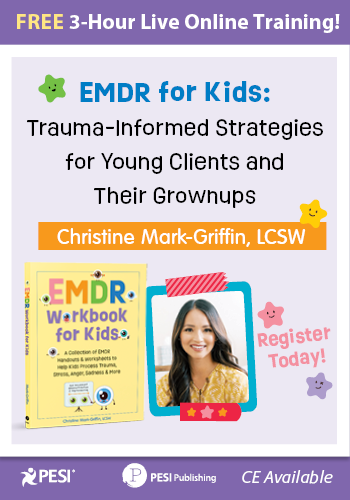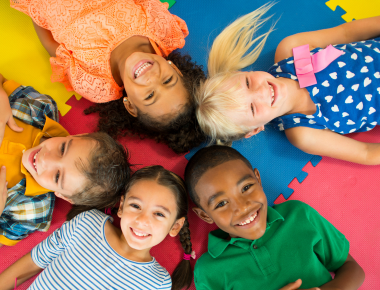EMDR with Children: Top 3 Challenges You’ll Face & How to Overcome Them
Help young clients cope with their symptoms using EMDR

Eye movement desensitization and reprocessing (EMDR) therapy is a form of psychotherapy that uses eye movements, sound, and tactile stimulation to help clients process traumatic experiences. EMDR therapy can be beneficial for children who have experienced trauma or struggling with other mental health issues.
An EMDR therapist can help young clients figure out which of their memories are getting stuck and giving them problems. They will be asked to focus on these upsetting memories while using back-and-forth movements, like moving your eyes, tapping, marching, using buzzers, or listening to sounds, to help their brains and bodies get unstuck. These movements are all types of bilateral stimulation—meaning that they light up both sides of your brain and body.
The goal of EMDR is to help your child find ways to cope with their symptoms so they can be a kid again! Below are 3 challenges you might face when working with young clients and strategies that can help you overcome them.
How to overcome it: Consider the child's development and adapt the frequency, intensity and length of the EMDR session as appropriate. EMDR therapy can even be used for 5 to 10 minutes at a time; the remaining time in the session can be dedicated to play, expressive art or practicing new coping skills.
How to overcome it: Be sure to fully explain EMDR, its process, and what the adults—and their child—can expect. Consider conjoint EMDR sessions with the child and their adults in the same room. EMDR therapists have the opportunity to not only help a child heal from their trauma, but foster healing for attachment wounds and address potential vicarious trauma for the adult in relation to the child.
How to overcome it: Though EMDR has its black-and-white script, it doesn’t mean you can’t alter portions of the process for your younger clients. Kids want to move and have fun, and this is how they learn! Adapt EMDR for kids with drawing, art, games, storytelling, and more. Help them engage in the bilateral movements by using rhythm, music, and movement with instruments or apps such as Spotify. Finally, have fun or calming activities prepared and allow for time at the end of a session so that children can feel grounded, stable and safe again after their session.
An EMDR therapist can help young clients figure out which of their memories are getting stuck and giving them problems. They will be asked to focus on these upsetting memories while using back-and-forth movements, like moving your eyes, tapping, marching, using buzzers, or listening to sounds, to help their brains and bodies get unstuck. These movements are all types of bilateral stimulation—meaning that they light up both sides of your brain and body.
The goal of EMDR is to help your child find ways to cope with their symptoms so they can be a kid again! Below are 3 challenges you might face when working with young clients and strategies that can help you overcome them.
Challenge #1: EMDR Therapy was Created for Adults
EMDR therapy was originally designed for adults. As a result, it may not always be the best fit for children. Children's brains are still developing and therefore have different capacities than adults' brains. Just like all forms of therapy, this means that EMDR may need to be adapted when working with young clients; otherwise, you might not see the progress or results you want from EMDR therapy sessions with them.How to overcome it: Consider the child's development and adapt the frequency, intensity and length of the EMDR session as appropriate. EMDR therapy can even be used for 5 to 10 minutes at a time; the remaining time in the session can be dedicated to play, expressive art or practicing new coping skills.
Challenge #2: Working with a Child Means Working with their Adults
Unfortunately, kids are rarely the ones who say, “I want to go and do EMDR therapy to reprocess my trauma.” Working with the adults involved in the child's life may pose a variety of challenges. Some adults need excessive communication regarding their child’s progress. Some may have a difficult time making changes at home. And in the most serious cases, the adults in a child's life may be the perpetrator or are actively involved in contributing to the trauma. One of the biggest challenges when working with children and trauma with EMDR is assessing if the trauma is still active. For example, the child could be in the middle of a nasty custody battle or living in a chaotic home environment.How to overcome it: Be sure to fully explain EMDR, its process, and what the adults—and their child—can expect. Consider conjoint EMDR sessions with the child and their adults in the same room. EMDR therapists have the opportunity to not only help a child heal from their trauma, but foster healing for attachment wounds and address potential vicarious trauma for the adult in relation to the child.
Challenge #3: The Scripted Protocol Leaves Little Room for Innovation
If you are a therapist who has gone through basic EMDR training, you are probably familiar with the phrase "stick to the script!" Basic EMDR training provides a script for EMDR standard protocol to guide and support therapists in administering the 8 phases of EMDR therapy correctly. In a field like psychology, it might seem like an advantage for therapists to have their work planned out in advance. However, many report feeling robotic and awkward when reading the script. Additionally, they find it challenging to adapt the script in a more child friendly language.How to overcome it: Though EMDR has its black-and-white script, it doesn’t mean you can’t alter portions of the process for your younger clients. Kids want to move and have fun, and this is how they learn! Adapt EMDR for kids with drawing, art, games, storytelling, and more. Help them engage in the bilateral movements by using rhythm, music, and movement with instruments or apps such as Spotify. Finally, have fun or calming activities prepared and allow for time at the end of a session so that children can feel grounded, stable and safe again after their session.
EMDR for Kids: Trauma-Informed Strategies for Young Clients and Their Grownups

Join Christine Mark-Griffin, LCSW, certified EMDR clinician and EMDRIA-Approved Consultant, for this 3-hour training on May 4 at 1:00p CST to learn how to help families unravel complex trauma together so they can heal from the past and repair their relationship.
This workshop is absolutely free to watch live. Capacity is limited. Don’t miss out – reserve your spot today!
This workshop is absolutely free to watch live. Capacity is limited. Don’t miss out – reserve your spot today!
Meet the Expert:
Christine Mark-Griffin, LCSW, is a certified EMDR therapist and EMDRIA-approved consultant. She is the owner of Spark All Wellness, a private practice specializing in EMDR therapy with children, EMDR consultation for clinicians, and trauma-informed trainings for professional organizations. Christine started her social work career in child protective serves and later transitioned to school-based mental health, where she was a clinical supervisor and trainer. Christine lectures at California State University, Monterey Bay, where she teaches undergraduate coursed in abnormal child psychology. Christine lives in San Francisco with her husband, two children, and dog. The things that make her happiest include her family and friends, a good cup of coffee, baked goods, yoga, traveling, cycling, music and dancing.
Learn more about her educational products, including upcoming live seminars, by clicking here.
Learn more about her educational products, including upcoming live seminars, by clicking here.



